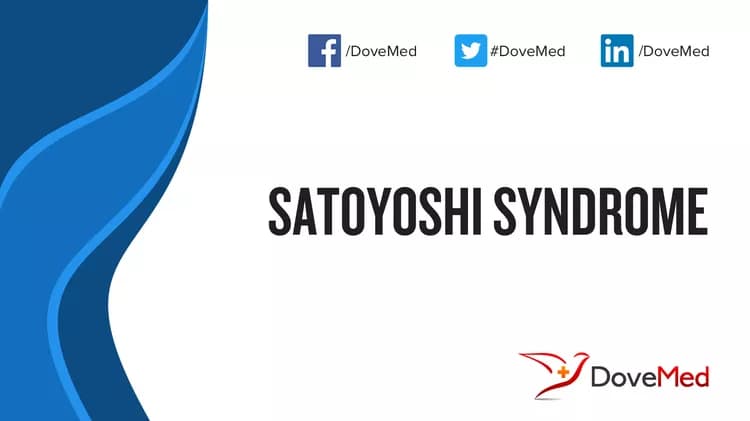What are the other Names for this Condition? (Also known as/Synonyms)
- Komuragaeri Disease
- Muscle Spasms, Intermittent with Alopecia, Diarrhea and Skeletal Abnormalities
What is Satoyoshi Syndrome? (Definition/Background Information)
- Satoyoshi Syndromeis a rare syndrome characterized by progressive, painful, intermittent muscle spasms
- These muscle spasms usually start between 6-15 years old. Other symptoms of the syndrome may include diarrhea and an inability of the digestive tract to absorb certain foods, especially carbohydrates (malabsorption)
- People affected by Satoyoshi Syndrome may also have loss of hair on the head and body (alopecia universalis), short stature, and skeletal abnormalities. Women with Satoyoshi Syndrome may not have a menstrual cycle (amenorrhea)
- In all published cases, only one person in a family has Satoyoshi Syndrome. This is even true when the person with Satoyoshi Syndrome comes from a large family. Satoyoshi Syndrome seems to be more common in Japan
- The exact cause of the syndrome is unknown, but some researchers think it may be an autoimmune disease
- Satoyoshi Syndrome can be diagnosed when a doctor sees symptoms that are consistent with the syndrome. The diagnosis can be confirmed by a variety of laboratory tests
- Treatment for Satoyoshi Syndrome includes medication to suppress the immune system
(Source: Satoyoshi Syndrome; Genetic and Rare Diseases Information Center (GARD) of National Center for Advancing Translational Sciences (NCATS), USA.)
Who gets Satoyoshi Syndrome? (Age and Sex Distribution)
- Satoyoshi Syndrome is a rare disorder. The presentation of symptoms are known to occur in childhood between the ages 6 and 15 years
- Both males and females may be affected
- Worldwide, individuals of all racial and ethnic groups may be affected; although, a higher number of cases are reported from Japan
What are the Risk Factors for Satoyoshi Syndrome? (Predisposing Factors)
- Currently, no risk factors have been clearly identified for Satoyoshi Syndrome
It is important to note that having a risk factor does not mean that one will get the condition. A risk factor increases one’s chances of getting a condition compared to an individual without the risk factors. Some risk factors are more important than others.
Also, not having a risk factor does not mean that an individual will not get the condition. It is always important to discuss the effect of risk factors with your healthcare provider.
What are the Causes of Satoyoshi Syndrome? (Etiology)
Scientists don’t yet understand exactly what causes Satoyoshi Syndrome, but research suggests that it is caused by the immune system mistakenly attacking cells in the nervous, gastrointestinal, and endocrine system.
- Normally, our immune system protects our body by attacking and destroying disease causing bacteria and viruses, but during an autoimmune response, the immune system attacks healthy cells of its own body
- About 60% of people with Satoyoshi Syndrome have antinuclear antibodies in their bloodstream
- These antibodies are produced by the immune system and attack the nucleus of cells throughout the body. Other people with Satoyoshi Syndrome may have other antibodies as well, such as antibodies against glutamic acid decarboxylase (GAD)
- For people with Satoyoshi Syndrome, it is thought that these antibodies target the nervous system, causing muscle spasms, and the gastrointestinal system, causing diarrhea and malabsorption
- In some cases the antibodies may attack the hormone or endocrine system in women, causing amenorrhea
- As is the case with most autoimmune diseases, there are no genetic changes that are known to cause or raise the risk of developing Satoyoshi Syndrome
- In general, scientists believe autoimmune disorders are caused by a combination of genetic and environmental factors, so often, especially in large families, more than one person has the autoimmune disease
- But there have not been any reported cases of more than one family member having Satoyoshi Syndrome
- Therefore it is not clear if there are any inherited genetic factors that increase the risk of developing Satoyoshi Syndrome
(Source: Satoyoshi Syndrome; Genetic and Rare Diseases Information Center (GARD) of National Center for Advancing Translational Sciences (NCATS), USA.)
What are the Signs and Symptoms of Satoyoshi Syndrome?
The signs and symptoms of Satoyoshi Syndrome may include:
- Diarrhea
- Genu valgum
- Malabsorption
- Mildly elevated creatine phosphokinase
- Osteolytic defects of the phalanges of the hand
- Pes planus
- Skeletal muscle hypertrophy
Very frequently present symptoms in 80-99% of the cases:
- Abnormality of epiphysis morphology
- Abnormality of femur morphology
- Abnormality of the hip bone
- Abnormality of the humerus
- Abnormality of the metaphysis
- Abnormality of the wrist
- Alopecia
- Amenorrhea
- Genu varum
- Hyperlordosis
- Hypoplasia of the ovary
- Hyperplasia of the uterus
- Intermittent painful muscle spasms
- Microcephaly
- Nephrogenic diabetes insipidus
- Sparse or absent eyelashes
- Tapered finger
Occasionally present symptoms in 5-29% of the cases:
- Brachydactyly
- Short metacarpal
- Short metatarsal
(Source: Satoyoshi Syndrome; Genetic and Rare Diseases Information Center (GARD) of National Center for Advancing Translational Sciences (NCATS), USA.)
How is Satoyoshi Syndrome Diagnosed?
- A diagnosis of Satoyoshi Syndrome is typically made based on a person having symptoms consistent with the syndrome
- One research group suggests the diagnosis of Satoyoshi Syndrome may be based on a person having alopecia, muscle spasms, and gastrointestinal problems such as diarrhea
- A number of laboratory tests may also be completed to confirm the diagnosis of Satoyoshi Syndrome. A doctor may recommend a blood test to look for antibodies related to Satoyoshi Syndrome
- It may also be helpful to study how the muscles behave when they are spasming, so electromyography (EMG) may be recommended
- Some reports also suggest that people with Satoyoshi Syndrome have elevated levels of glycine in their cerebrospinal fluid (CSF), so a CSF collection may also be recommended
(Source: Satoyoshi Syndrome; Genetic and Rare Diseases Information Center (GARD) of National Center for Advancing Translational Sciences (NCATS), USA.)
Many clinical conditions may have similar signs and symptoms. Your healthcare provider may perform additional tests to rule out other clinical conditions to arrive at a definitive diagnosis.
What are the possible Complications of Satoyoshi Syndrome?
The complications of Satoyoshi Syndrome may include:
- Gastrointestinal abnormalities
- Infertility in women
- Unable to walk
- Physical deformities
- Intellectual impairment
Complications may occur with or without treatment, and in some cases, due to treatment also.
How is Satoyoshi Syndrome Treated?
There is no cure for Satoyoshi Syndrome, but treatments are available for the different symptoms a person may have.
- Medications that suppress the immune system may be used to help prevent the immune system from attacking the body. These medications may include corticosteroids
- Certain medications may work better for some people than others, so a doctor may have to try different medications to find the exact combination that works best for each person
- In some cases, plasmapheresis has been shown to help improve symptoms of people with Satoyoshi Syndrome who have not responded to other treatment options
(Source: Satoyoshi Syndrome; Genetic and Rare Diseases Information Center (GARD) of National Center for Advancing Translational Sciences (NCATS), USA.)
How can Satoyoshi Syndrome be Prevented?
- Currently, Satoyoshi Syndrome may not be preventable, since the exact cause of the disorder is unidentified
- Regular medical screening at periodic intervals with tests and physical examinations are recommended
What is the Prognosis of Satoyoshi Syndrome? (Outcomes/Resolutions)
The long-term outlook for people affected by Satoyoshi Syndrome may vary.
- Some people with the syndrome respond well to treatment and symptoms may completely go away. Other people may not get better with current treatment options
- Although women with Satoyoshi Syndrome may have irregular menstrual periods, there have been reports of women with the syndrome who were able to become pregnant
- Satoyoshi Syndrome may be life-limiting due to worsening symptoms if treatment is not successful
- Satoyoshi Syndrome may also be life-limiting if a person with the condition suffers from mental health problems due to the symptoms causing challenges in daily living
(Source: Satoyoshi Syndrome; Genetic and Rare Diseases Information Center (GARD) of National Center for Advancing Translational Sciences (NCATS), USA.)
Additional and Relevant Useful Information for Satoyoshi Syndrome:
The following DoveMed website link is a useful resource for additional information:
Related Articles
Test Your Knowledge
Asked by users
Related Centers
Related Specialties
Related Physicians
Related Procedures
Related Resources
Join DoveHubs
and connect with fellow professionals


0 Comments
Please log in to post a comment.